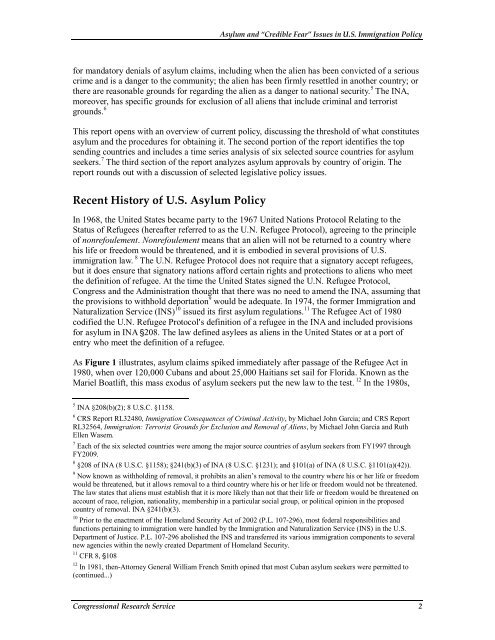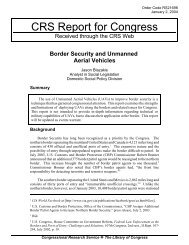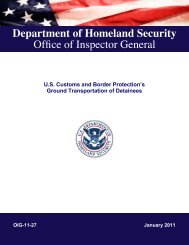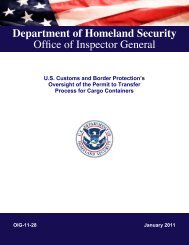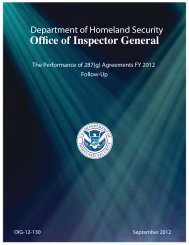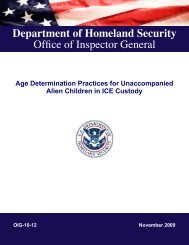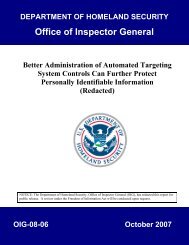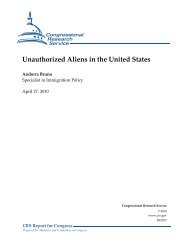Asylum and "Credible Fear" Issues in U.S. Immigration Policy
Asylum and "Credible Fear" Issues in U.S. Immigration Policy
Asylum and "Credible Fear" Issues in U.S. Immigration Policy
Create successful ePaper yourself
Turn your PDF publications into a flip-book with our unique Google optimized e-Paper software.
<strong>Asylum</strong> <strong>and</strong> “<strong>Credible</strong> Fear” <strong>Issues</strong> <strong>in</strong> U.S. <strong>Immigration</strong> <strong>Policy</strong>for m<strong>and</strong>atory denials of asylum claims, <strong>in</strong>clud<strong>in</strong>g when the alien has been convicted of a seriouscrime <strong>and</strong> is a danger to the community; the alien has been firmly resettled <strong>in</strong> another country; orthere are reasonable grounds for regard<strong>in</strong>g the alien as a danger to national security. 5 The INA,moreover, has specific grounds for exclusion of all aliens that <strong>in</strong>clude crim<strong>in</strong>al <strong>and</strong> terroristgrounds. 6This report opens with an overview of current policy, discuss<strong>in</strong>g the threshold of what constitutesasylum <strong>and</strong> the procedures for obta<strong>in</strong><strong>in</strong>g it. The second portion of the report identifies the topsend<strong>in</strong>g countries <strong>and</strong> <strong>in</strong>cludes a time series analysis of six selected source countries for asylumseekers. 7 The third section of the report analyzes asylum approvals by country of orig<strong>in</strong>. Thereport rounds out with a discussion of selected legislative policy issues.Recent History of U.S. <strong>Asylum</strong> <strong>Policy</strong>In 1968, the United States became party to the 1967 United Nations Protocol Relat<strong>in</strong>g to theStatus of Refugees (hereafter referred to as the U.N. Refugee Protocol), agree<strong>in</strong>g to the pr<strong>in</strong>cipleof nonrefoulement. Nonrefoulement means that an alien will not be returned to a country wherehis life or freedom would be threatened, <strong>and</strong> it is embodied <strong>in</strong> several provisions of U.S.immigration law. 8 The U.N. Refugee Protocol does not require that a signatory accept refugees,but it does ensure that signatory nations afford certa<strong>in</strong> rights <strong>and</strong> protections to aliens who meetthe def<strong>in</strong>ition of refugee. At the time the United States signed the U.N. Refugee Protocol,Congress <strong>and</strong> the Adm<strong>in</strong>istration thought that there was no need to amend the INA, assum<strong>in</strong>g thatthe provisions to withhold deportation 9 would be adequate. In 1974, the former <strong>Immigration</strong> <strong>and</strong>Naturalization Service (INS) 10 issued its first asylum regulations. 11 The Refugee Act of 1980codified the U.N. Refugee Protocol=s def<strong>in</strong>ition of a refugee <strong>in</strong> the INA <strong>and</strong> <strong>in</strong>cluded provisionsfor asylum <strong>in</strong> INA '208. The law def<strong>in</strong>ed asylees as aliens <strong>in</strong> the United States or at a port ofentry who meet the def<strong>in</strong>ition of a refugee.As Figure 1 illustrates, asylum claims spiked immediately after passage of the Refugee Act <strong>in</strong>1980, when over 120,000 Cubans <strong>and</strong> about 25,000 Haitians set sail for Florida. Known as theMariel Boatlift, this mass exodus of asylum seekers put the new law to the test. 12 In the 1980s,5 INA §208(b)(2); 8 U.S.C. §1158.6 CRS Report RL32480, <strong>Immigration</strong> Consequences of Crim<strong>in</strong>al Activity, by Michael John Garcia; <strong>and</strong> CRS ReportRL32564, <strong>Immigration</strong>: Terrorist Grounds for Exclusion <strong>and</strong> Removal of Aliens, by Michael John Garcia <strong>and</strong> RuthEllen Wasem.7 Each of the six selected countries were among the major source countries of asylum seekers from FY1997 throughFY2009.8 §208 of INA (8 U.S.C. §1158); §241(b)(3) of INA (8 U.S.C. §1231); <strong>and</strong> §101(a) of INA (8 U.S.C. §1101(a)(42)).9 Now known as withhold<strong>in</strong>g of removal, it prohibits an alien’s removal to the country where his or her life or freedomwould be threatened, but it allows removal to a third country where his or her life or freedom would not be threatened.The law states that aliens must establish that it is more likely than not that their life or freedom would be threatened onaccount of race, religion, nationality, membership <strong>in</strong> a particular social group, or political op<strong>in</strong>ion <strong>in</strong> the proposedcountry of removal. INA §241(b)(3).10 Prior to the enactment of the Homel<strong>and</strong> Security Act of 2002 (P.L. 107-296), most federal responsibilities <strong>and</strong>functions perta<strong>in</strong><strong>in</strong>g to immigration were h<strong>and</strong>led by the <strong>Immigration</strong> <strong>and</strong> Naturalization Service (INS) <strong>in</strong> the U.S.Department of Justice. P.L. 107-296 abolished the INS <strong>and</strong> transferred its various immigration components to severalnew agencies with<strong>in</strong> the newly created Department of Homel<strong>and</strong> Security.11 CFR 8, '10812 In 1981, then-Attorney General William French Smith op<strong>in</strong>ed that most Cuban asylum seekers were permitted to(cont<strong>in</strong>ued...)Congressional Research Service 2


